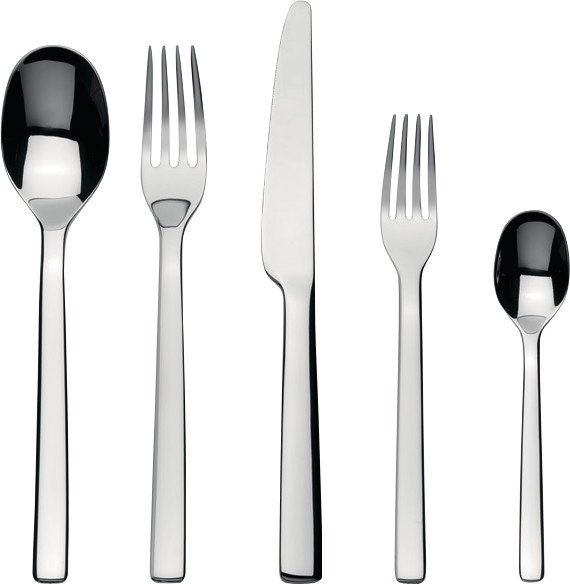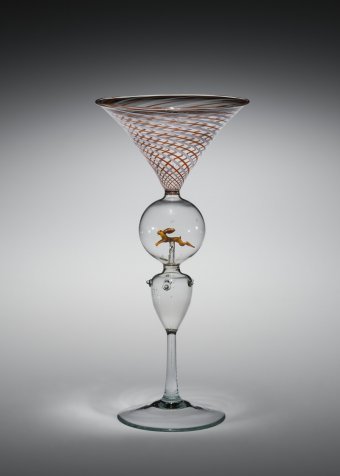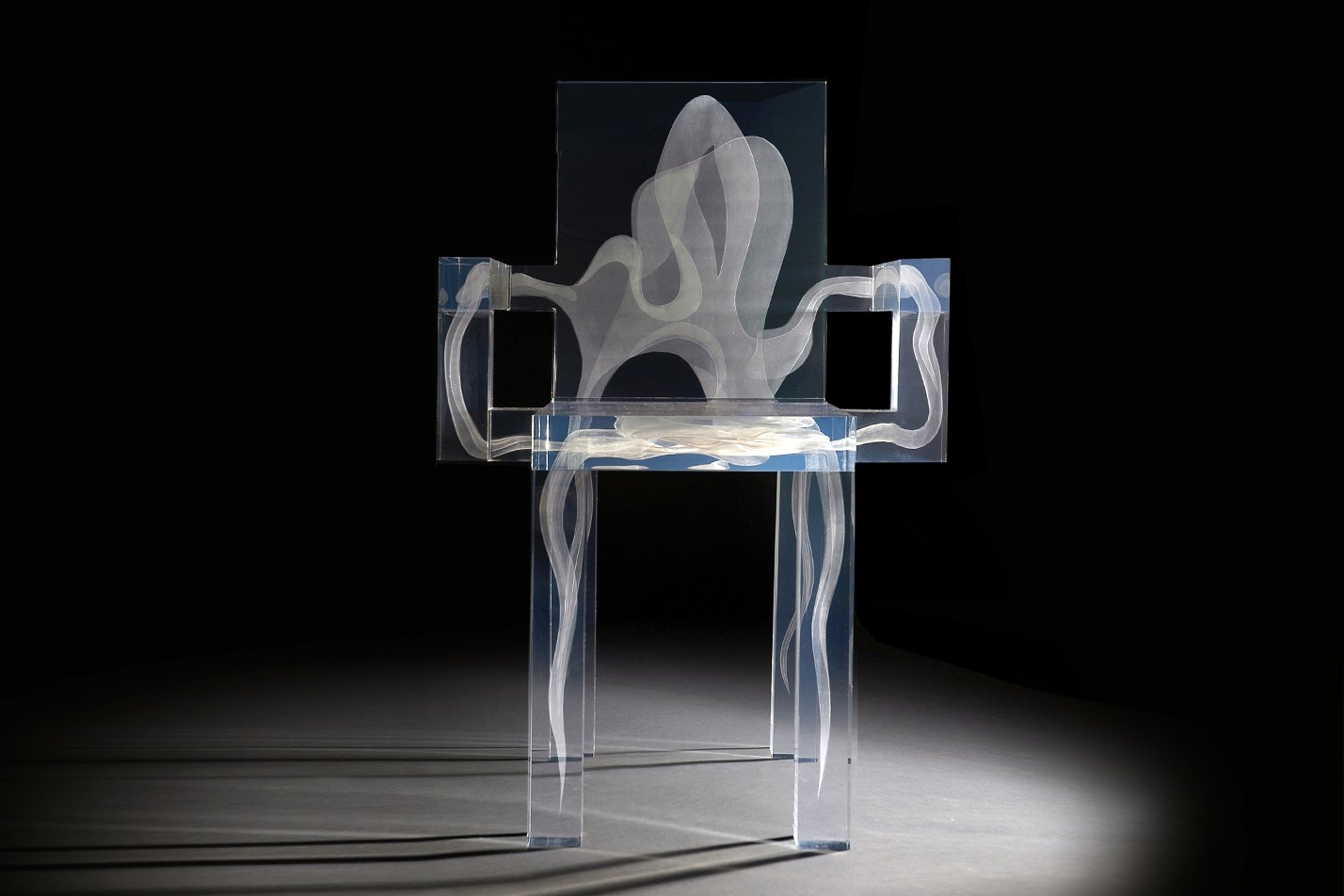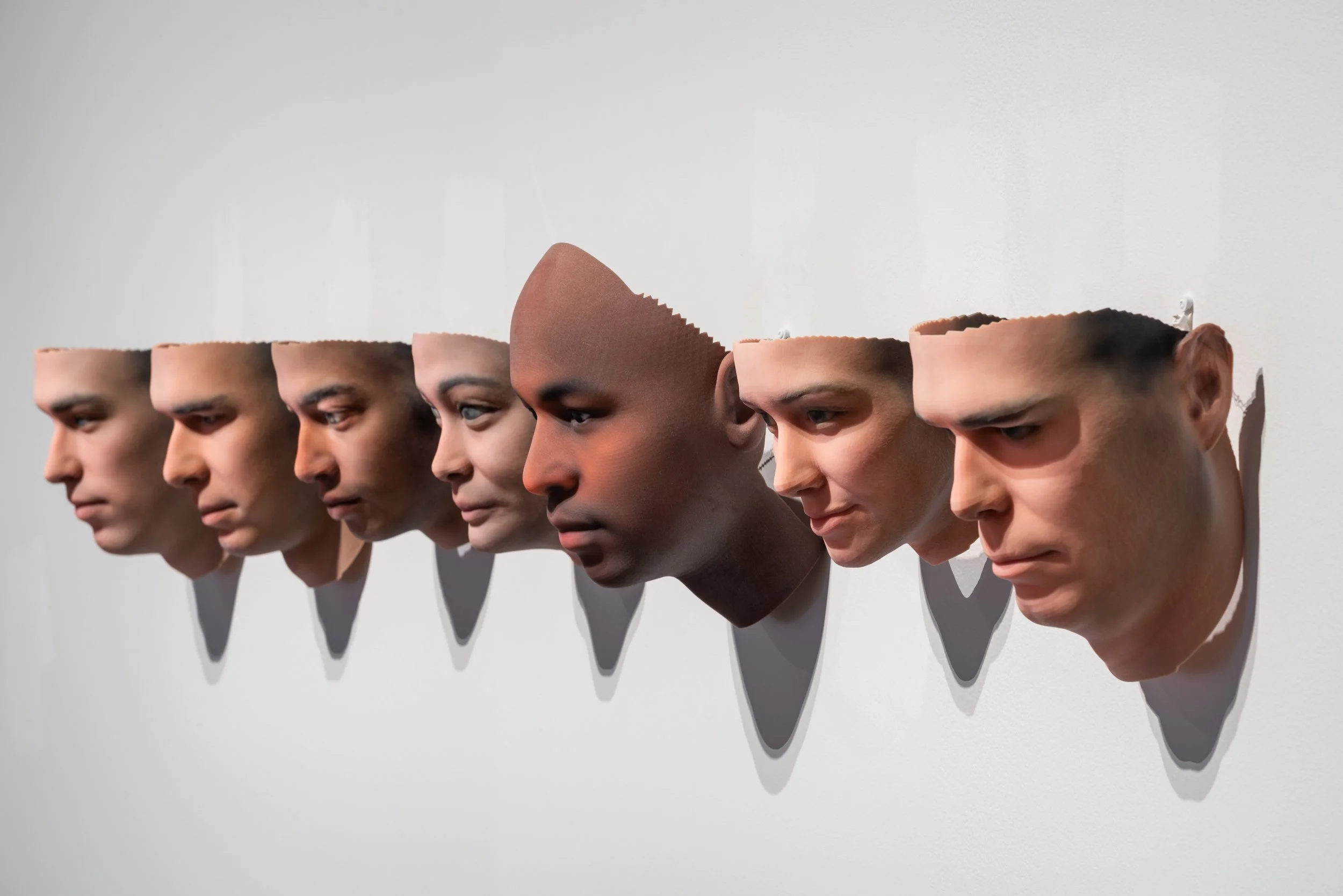Recent Design Acquisitions 2021 -2022
Lausanne, TSF Leyvraz-Genton Poster
"Lausanne, TSF Leyvraz-Genton" Poster. Designed and made by Publivox (Swiss, active c. 1920-1940) c. 1930. Color lithograph. 50 × 35 inches (127 × 88.9 cm). Poster for Lausanne, TSF Leyvraz-Genton, a Swiss power provider. 2021-84-3.
Commissioned by the Lausanne, Switzerland, radio manufacturer Leyvraz, Genton & Cie, this poster was designed and published by Publivox, a Swiss advertising company with its own in-house designers. Radio broadcasts began in Switzerland in 1920 and the novelty and technological wonder of instant mass communication over long distances is depicted in this poster by a glowing spiral of radio waves that encircles the globe in outer space, punctuated by a jagged red lightning bolt.
Purchased with the proceeds from the sale of deaccessioned works of art, 2021.
Ovale Flatware
Pieces from the “Ovale” Flatware Set. Designed by Ronan Bouroullec (French, born 1971) and Erwan Bouroullec (French, born 1976). Made by Alessi S.p.A. (Crusinallo, Italy, 1921 – present) 2012. Stainless steel. Tablespoon: 8 inches (20.3 cm) | Alessi code: REB09/1. Table fork: 8 inches (20.3 cm) | Alessi code: REB09/2. Table knife: 8 3/4 inches (22.2 cm) | Alessi code: REB09/3. Dessert fork: 6 3/4 inches. (17.1 cm) | Alessi code: REB09/5. Teaspoon: 5 1/2 inches (14 cm) | Alessi code: REB09/7. 2021-85-1-5
The “Ovale” cutlery set and salad servers are typical examples of the Bouroullecs’ balanced approach to design, harmonizing a delicacy of form with practical requirements of function. Intended as a complement to their “Ovale” dining service (2010) also made by Alessi, these pleasing and simple objects embody an important aspect of the Bouroullecs’ design ethos.
In their words: “The Ovale collection strives to be original, but it also wants to be rustic and traditional. We set out in pursuit of delicate expression. This composition speaks about everyday life, about breakfast, lunch, about everyone getting together for dinner. There is a desire for simplicity.”
Purchased with the proceeds from the sale of deaccessioned works of art, 2021. Gift of Alessi S.p.A., Crusinallo, Italy.
Cocktail Glasses
Cocktail Glasses (seven). Made by Bimini Glas (founded Vienna 1923) c. 1930. Flame-worked and tooled colorless and multi-colored glass. Approx.: 7 7/16 × 3 1/2 inches (18.9 × 8.9 cm). 2021-101-1
At the great International Exhibition of Modern Decorative and Industrial Arts held in Paris in 1925, the Viennese firm of Bimini Glass was awarded a silver medal - a tremendous achievement for a small company founded only two years earlier, bringing with it, international recognition and sales. These cocktail glasses embody all the technical craft that made Bimini so successful: flame-worked and tooled in both colorless and multi-colored glass, its conical bowls are decorated with colorful swirls atop circular knops that contain tiny figures of animals.
Sadly, the firm survived only fifteen years: in 1938 when the Fascist Austrian government decreed that non-Aryans could no longer operate businesses, Fritz Lampl (1892-1955), Bimini’s Jewish founder, emigrated with his wife to England.
Gift of Nancy Toll Harris and Dan E. Harris in memory of Maisie Maxfield Toll and Gerald S. Toll, 2021
Jewelry and Pieces from the Les Phagocytes Service






This handsome group of jewelry by Claude Lalanne joins another work by the artist in the Museum’s collection, the pair of “Structure Végétale” wall lights that Anne d’Harnoncourt, then the Museum’s Director, acquired for the Museum in 2002 (2002-78-1).
That Anne acquired a pair of the same wall lights for her own home on Delancey Place in Philadelphia, testifies to her personal feelings for and interest in Claude Lalanne’s work. She had met Lalanne in France, probably through Alexina “Teeny” Duchamp, a neighbor of the Lalannes, and likely purchased most of this original and well -crafted jewelry directly from the artist.
Impressing, moulding, and electroplating human and vegetal forms in unexpected combinations, Claude Lalanne created sculptural objects whose surreal and humorous dimensions seem to have resonated deeply with Anne.
Gifts of the Estate of Joseph J. Rishel
Gebr Fretz Poster
“Gebr Fretz” Poster. Walter Koch (German, 1875 – 1915) 1910. Lithograph. 48 7/8 × 35 3/4 inches (124.2 × 90.8 cm)
As a fine printer’s choice of designer, German painter Walter Koch produced this poster for the prominent Swiss printing firm Gebrüder Fretz, notable for its letterpress printing, lithography (like this example) as well as offset, gravure, and binding. The tight geometric patterns of the flowering tree and its candelabra-like branches suggest a source of Koch’s inspiration in the Vienna Secession and Workshops.
Reference
https://www.wikipe.wiki/wiki/de/Walter_Koch_(Maler,_1875)
Purchased with the proceeds from the sale of deaccessioned works of art
Queen Chair
"Queen" Chair from the "Ghost Collection.” Designed by Lonneke Gordijn, (Dutch, born 1980) and Ralph Nauta, (Dutch, born 1978). Made by DRIFT, Amsterdam, founded 2007. Designed 2008; made 2022. Laser etched acrylic. 35 7/16 × 23 5/8 × 19 11/16 inches, 77.2 lb. (90 × 60 × 50 cm, 35 kg)
Designed by Amsterdam-based duo Lonneke Gordijn and Ralph Nauta, the Ghost Collection debuted at the 2008 Salone del Mobile in Milan and remains a highly successful use of digital fabrication for expressive and conceptual ends. Cast in clear acrylic, the reductive silhouettes of the furniture seem at first glance to be bound by the geometric language of modernism. But under certain lighting conditions, a set of ghostly inner forms appear, providing an organic and poetic counterpoint to the outwardly rigid and unassuming shapes.
These inner forms are generated with a computer-controlled laser system that enables the designers to “draw” in three dimensions inside the acrylic body of the furniture. Gordijn and Nauta formed their studio DRIFT in 2007, having both studied at the Design Academy Eindhoven, one of Europe’s centers for innovative design practice. capitalism.
Now a studio team of more than five dozen, DRIFT will be honored with the 2022 Collab Design Excellence Award and a corresponding exhibition
Purchased with the Walter E. Stait Fund
Stranger Visions
"Stranger Visions" (seven). Heather Dewey-Hagborg, (American, born 1982). Printed by LaGuardia Studio, NYU, founded c. 2008. Designed 2012-2013; made 2019. 3D-printed plastic. Each (approx.): 8 × 6 × 6 inches (20.3 × 15.2 × 15.2 cm)
Challenging mainstream design, this project offers an alternative vision of design practice that encourages debate about society and the impact of emerging technologies. Stranger Visions takes genetic engineering and surveillance as its theme, casting a critical light on the access of someone’s genetic information without their knowledge or consent.
Collecting discarded chewing gum, loose hairs, cigarette butts and other bits of saliva-covered debris from the streets of New York, transdisciplinary designer Heather Dewey-Hagborg worked with a lab to extract DNA from these samples. Focusing on the genetic material that codes for physical traits, she entered this data into a facial-modeling computer program, which then allowed her to produce physical models with a 3D printer.
These life-sized portraits while inexact, bear a “family resemblance” to the people who left behind their gum, hair, and cigarette butts in terms of their gender, eye, hair, and skin color, nose width, and distance between their eyes. Displayed in the Museum’s 2019-2020 exhibition Designs for Different Futures, this series of portrait sculptures presents a disturbing image of the way information can be gathered from and used to identify unsuspecting strangers.
Purchased with the European Decorative Arts Revolving Fund
Mido Chair
"Mido" Chair. Designed by Jomo Tariku, (Ethiopian American, born 1969). Made by Jomo Tariku and David Bohnhoff, (American, born 1968). Designed 2021; made 2022. Walnut veneer. 37 1/4 × 16 7/8 × 18 15/16 inches. (94.6 × 42.9 × 48.1 cm)
Ethiopian American industrial designer Jomo Tariku draws his inspiration from African and Black diasporic culture and history. He launched his own company, Jomo Furniture, in 2017 in order to showcase his growing line of sculptural chairs and stools. Tariku’s striking “Mido” chair is his most powerful design yet.
Made from bent veneered walnut, the chair takes the form of an abstracted Afro-pick hair comb. The word “Mido” means “comb” in Amharic and the design synthesizes the rich history of the Afro comb with the African tradition of a ceremonial seat signifying leadership, unity, and kinship. The Afro comb holds deep meaning both within Black culture in the US and Sub-Saharan regions of Africa, with a history that goes back at least 6,000 years in Sudan.
For centuries, Africans have styled and decorated their hair using such combs in order to indicate their age, religion, wealth, marital status, and social status. For Tariku, the Mido chair celebrates the resilient spirit of the African diaspora.
Purchased with funds contributed by Techné, the European Decorative Arts Revolving Fund, and the Collab Acquisition Fund for BIPOC Designers created by Lisa Roberts and David Seltzer.
ARKLU Chair
"ARKLU" Chair. Designed by Henry Klumb, (American [born Germany], 1904 – 1984). Made by ARKLU, Puerto Rico, 1944 – 1948. 1944-1948. Wood, woven cord. Approx.: 31 1/2 × 21 3/4 × 27 inches (80 × 55.2 × 68.6 cm)
Born in Cologne, Germany, Henry Klumb trained in architecture at the local technical college before emigrating in 1927 to the United States. He secured a coveted fellowship in Frank Lloyd Wright’s Taliesin office, working up to the position of senior draftsperson, and worked briefly with prominent Philadelphia architect Louis I. Kahn in the 1930s.
In 1944, Klumb relocated to Puerto Rico at the invitation of the territory’s governor, Rexford Tugwell, to serve as a lead architect for the Committee on Design of Public Works. In a career that continued over four decades more, he became one of the island’s most prolific architects and a steadfast advocate for modernism as an appropriate form of building in the tropics. —against a backdrop of the popular Spanish colonial revival style.
This chair was one of the designs produced by ARKLU, a small furniture manufacturing company Klumb co-founded in Puerto Rico with another former Taliesin Fellow, Stephen Arneson. With a frame built from tropical hardwood and a seat and back strung with woven cord, the chair simultaneously meshes local traditions and materials with broader design trends in American and Scandinavian furniture of the period.
Gift of Darrel Sewell
One for the Recession Wall Lamp
"One for the Recession" Wall Lamp. Designed by Ingo Maurer, (German, 1932 – 2019). Designed 1985. Enameled metal, screen. 18 1/8 × 11 7/16 × 3 9/16 inches (46 × 29 × 9 cm)
Its title referring to the global recession of the early 1980s as well as to its strict economy of materials and design, One for the Recession is the first of several lamps designed by Ingo Maurer featuring red hearts (including One from the Heart, 1989, and Kokoro, 1998). Here, sheets of red-finished steel that resemble the halves of a cut-and-folded paper Valentine, enclose a halogen light bulb.
Gift of Ofelia Garcia
Campari Light
"Campari" Light. Designed by Raffaele Celentano, (Italian, born 1962). Made by Ingo Maurer GmbH, Munich, 1966 – present. Designed 2002. 10 Campari bottles, plastic, metal. Diameter: 9 1/16 inches (23 cm). Cord length (min): 61 inches (155 cm). Cord length (max): 13 feet 1 1/2 inches (400 cm)
Channeling the humor and nod to Pop culture that distinguished Ingo Maurer’s production, this suspension lamp consists of ten original Campari Soda bottles, each removable and replaceable with new Campari bottles as their contents are consumed.
Combining Campari’s distinctive dark red liqueur with soda water, Campari Soda is a pre-mixed drink made and bottled by the Campari company for the Italian market. Its handsome bottle was designed by the artist Fortunato Depero (Italian, 1892-1960) in 1932. The bottles are placed around and largely conceal a central light source which casts a reddish glow as the light shines downward through the liqueur. The lamp was designed for and with Ingo Maurer by photographer Raffaele Celentano (Italian, b. 1962) when he moved to Munich from Naples in the mid-1980s to teach Italian linguistics.
Gift of Ofelia Garcia
Verre d’églomisé
Verre d’églomisé. Barbara Nanning, (Dutch, born 1957) 2007. Glass, blown, hand‑formed, 23.5‑karat orange gold. 9 7/16 × 11 × 10 1/4 inches (24 × 28 × 26 cm)
Dutch artist Barbara Nanning (b. 1957), who graduated from the prestigious Gerrit Rietveld Academie in Amsterdam, started working with glass in the early 1990s after beginning her career as a ceramicist. She has always pushed the boundaries of her field and was one of the first ceramicists to use paint pigments instead of glazes on her wares. Nanning is deeply inspired by the shapes and colors found in nature, particularly those seen in crystals, jellyfish, flowers, and micro-organisms. Her works are often filled with contradictions—they unite amorphous and rigid structures, reflect the idea of both liberty and constraint, and combine unexpected materials.
This unique piece comes from a series of boldly colored glass vessels and reflects Nanning’s experimentations with pâte de verre, glass blowing, and metal gilding. The piece also demonstrates her creative use of color and texture in order to reflect light in unexpected ways. The vessel’s thick outer wall, which is curved, folded, and brightly colored, contrasts with a gilt interior and offers a variety of shimmering surface effects for the viewer’s delight.
Gift of Joern Lohmann
Taj Lamp
"Taj" Lamp. Designed by Pietro Ferruccio Laviani, (Italian, born 1960). Made by Kartell S.p.A., Milan, Italy, founded 1949. Designed 2012. Transparent PMMA. 24 7/16 × 21 7/8 × 5 7/8 inches, 5.5 lb. (62 × 55.5 × 15 cm, 2.5 kg)
Ferruccio Laviani has described this transparent thermoplastic table lamp as a kind of sculpture anyone can own, its bold, gestural form reminding him initially of an elephant’s tusk – hence the title, “Taj,” recalling the Indic word for “crown,” - but also of the singular curve of a comma. The designer wanted to avoid cluttering the lamp’s clean, simple shape with variants in multiple finishes and materials, initially producing Taj in just black and white with transparent, matte, and opaline surfaces. Taj was the manufacturer’s first lamp to use LED technology, ensuring the quality and color rendering of the light it produces. The lamp won Interior Design Magazine’s “Best of Year” Award in 2012, the same year it was released.
For Laviani, producing Taj was a huge technical challenge: the lamp needed to emerge perfectly from the mold free of shrinkage or other deformations and maintain the consistent high-quality production for which Kartell is known. Subsequently, Kartell has produced smaller versions of Taj in a wide variety of colors that work in a range of interior settings.
Gift of Roberta and Michael Gruber, 2022












